




Kindergarten
Next Generation Science
Energy K-PS3-2: Use tools and materials provided to design and build a structure that will reduce the warming effect of sunlight on Earth’s surface.


Copyright STEMTaught. All rights reserved. No part of this publication may by reproduced or distributed in any form, by any means, graphic, electronic, or mechanical, including photocopying, taping, and recording, or posting electronically in any location, any database or memory device without the prior written consent from STEMTaught.
Subscribing STEMTaught schools and teachers may reproduce and distribute STEMTaught material for use with their students.
Written by Jake Hunter, Beth Hunter and Aysha Imtiaz.
Illustrated by Lilly Hunter.
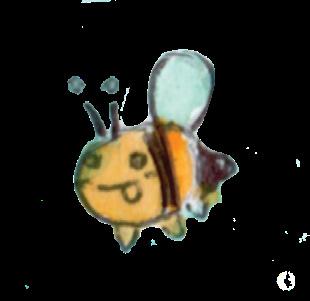
Teacher Edition SEEd ISBN 978-1-952346-15-6
Edition 3

STEM
Energy K-PS3-2: Use tools and materials provided to design and build a structure that will reduce the warming effect of sunlight on Earth’s surface.

In this unit, students design and build shade structures to reduce the warming effects of the Sun. This STEMTaught unit conforms to the following NGSS standards:
Students who demonstrate understanding can: K-PS3-2. Use tools and materials provided to design and build a structure that will reduce the warming effect of sunlight on Earth’s surface.* [Clarification Statement: Examples of structures could include umbrellas, canopies, and tents that minimize the warming effect of the sun.]
The performance expectation above was developed using the following elements from the NRC document A Framework for K-12 Science Education:
Constructing Explanations and Designing Solutions
Constructing explanations and designing solutions in K–2 builds on prior experiences and progresses to the use of evidence and ideas in constructing evidence-based accounts of natural phenomena and designing solutions.
Use tools and materials provided to design and build a device that solves a specific problem or a solution to a specific problem.
PS3.B: Conservation of Energy and Energy Transfer
Sunlight warms Earth’s surface.
Cause and Effect
Events have causes that generate observable patterns.
Observable features of the student performance by the end of the grade:
1 Using scientific knowledge to generate design solutions
a Students use given scientific information about sunlight’s warming effect on the Earth’s surface to collaboratively design and build a structure that reduces warming caused by the sun.
b With support, students individually describe *:
i. The problem.
ii. The design solution.
iii. In what way the design solution uses the given scientific information.
2 Describing* specific features of the design solution, including quantification when appropriate
a Students describe* that the structure is expected to reduce warming for a designated area by providing shade.
b Students use only the given materials and tools when building the structure.
3 Evaluating potential solutions
a Students describe* whether the structure meets the expectations in terms of cause (structure blocks sunlight) and effect (less warming of the surface).
In this unit, you will show pictures and ask questions to aid in class discussions, read stories and poems that will aid understanding of this NGSS standard, and guide your students in hands-on discovery. Get ready to have a lot of fun with your class! These prompts will guide you as you teach your class:
These text colors serve the following functions:
Blue Text: Questions that you can directly ask the class.
What does it feel like to be in sunlight on a hot, hot day?
Red text: Suggested teacher comments.
Example: Sunlight can make us sweaty, tired, or even sunburned. The brightness of sunlight can make us close or squint our eyes.
Black text: Text that you directly read to your class.
“We are going to go on a shade hunt outside...”
This teacher edition text, “Making Shade” corresponds to this student edition text, “The Three little Birds”


STEMTaught Curriculum Developer, Karachi, Pakistan

Disciplinary Core Ideas: PS3.B: Conservation of Energy and Energy Transfer
Sunlight warms Earth’s surface.
The warming effect of Earth’s sunlight is introduced here with the example of melted chocolate.

Show the author photo of Aysha to your students and read the passage with her story, then discuss the questions.
This is a photo of Aysha. She wrote this learning unit. Aysha has twin boys and a little girl. Aysha wanted to share this story about melting chocolate of a hot day with you:
Mahad, my three-minute older twin, really should have been born in Antarctica because like the hot weather where we live in Pakistan!
One hot summer day, Mahad brought home a KitKat chocolate bar from school and, of course in the hot weather it quickly became a sticky, melted mess. He was so disappointed. He asked me why Mother Nature didn’t turn on the winter air conditioner already, and how he’d give Mother Nature a kiss if she did.
That day, I started thinking about why and how shade can help us stay cool, and keep our chocolate cool too.
Ask
How could Mahad have protected his chocolate bar from melting?
Example: Summer heat can make chocolate melt. Sunlight can make chocolate melt even faster. Mahad needs to keep his chocolate in the shade. He must put it in a cool place to protect it from the summer heat.
Message from Aysha:
I’m so happy that you are all learning such amazing things in Kindergarten! I When you do your activities with STEMTaught, I feel like I’m with you, and that is the best feeling.

Disciplinary Core Ideas:
PS3.B: Conservation of Energy and Energy Transfer
Sunlight warms Earth’s surface.
With the TPS discussion prompt, “What does it feel like to be in sunlight on a hot, hot day?” students recall what it feels like to be in the sun. They discuss that the sun warms the Earth’s surface.
Show the photo to your students and read the passage, then discuss the questions.
Have you felt the Sun warming up your arms and legs in the summer? The Sun warms up the earth’s surface—and us! Sometimes sunshine is very pleasant. Sometimes sunshine is really hot! Do you like how good it feels to dip your feet into the cool water or take a long swim in the summer?
What does it feel like to be in sunlight on a hot, hot day?
Example: Sunlight can make us sweaty, tired, or even sun. The brightness of sunlight can make us close or squint our eyes.
We can’t always be in the water though, and we can’t always stay in our houses either! What are other ways we can stay cool?
What is another way to stay cool if you can’t be in the water?
Example: Shade can keep us cool. If you can get out of the sunlight on a hot day, it can feel quite pleasant in the shade of a tree.
Where can we find shade?
Example: Shade can be found under trees. We can wear a hat to shade our faces. We can sit under an umbrella at the beach.

Crosscutting Concepts: Cause and Effect
Events have causes that generate observable patterns.
The student will observe the difference in temperature from being in the shade and the sun. They will notice a pattern that shade areas are more cool.
Observable features of the student performance:
1. Using scientific knowledge to generate design solutions
b. With support, students individually describe (i.) the problem.
Students gain first-hand experience with shade and sunlight by making observations of what it feels like to be in the shade and in the sunlight on their school grounds. With the class discussion prompts, students describe the problem that they will work to solve by building a shade structure to reduce the warming effect of the sun.
Show the photo while you read and discuss the questions.
Do you see shade in this photo? What is making the shade? Example: Tree branches create shade.

Today we get to be scientists and observe what makes shade so special. These are amazing animals called Oryx. They live in the hot deserts of Arabia where it can reach temperatures of over 120° F (48° C)! They have to travel far to find plants to eat. Why do you think finding shade is important for their survival?
Define
Explain
Explore Ask Watch a short movie about the Oryx.
1.
Observe: To observe something means to carefully notice things. To observe shade, you can notice how the shadow feels and how it looks. You can describe its shape, size, and color.
Communicate your plan: Go out on the playground with your class to look for shade. Allow ample time for exploration. We are going to go on a shade hunt outside in the schoolyard. Think of all the best places you can look for shade.
Activity Plan:
Find a shadow: Look around in the schoolyard for shade.
3.
Step into the shade: Find shade and feel what it is like.
Observe how shade feels: How does it feel to be in the sunlight? How about the shade? What differences do you notice?
Take your students outside to explore the school grounds looking for shade.
- Help your students remember that they can make careful observations like a scientist. Ask them probing questions to help them notice things such as:
1. How does shade look?
2. How does shade feel?
3. What makes shade?
4. What size are the shadows?
5. What shape are the shadows?
6. Does shade move?
Walk with your students and encourage them to explore. Listen to their observations. Compliment them on what they discover.
Extension: After your students have explored shade outside for 15 minutes, revitalize interest by bringing out the thermometers! Have students compare the temperature in direct sunlight to temperatures in shaded areas.
Student book: Activity journaling pages
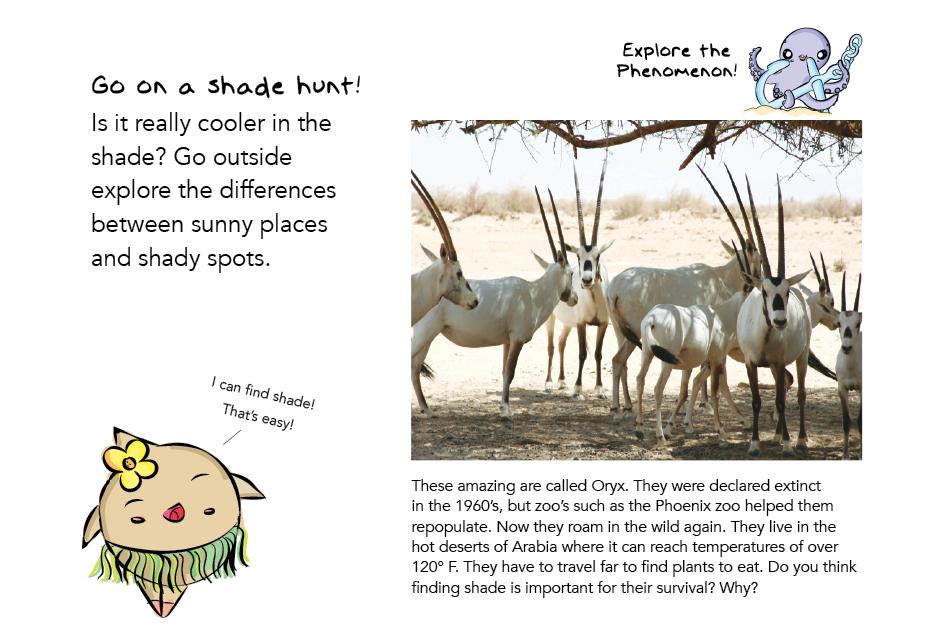
Back in the classroom, after exploring shade outside, pass out your students’ lab books. Each student will record a science journal entry on the pages of their book shown below.

Explain
You just made careful observations like a scientist. Scientists also write down their observations. Open your books to these pages.
Shade is a gray, dark area that is made when something blocks light. Another word for shade is Shadow. An object’s gray shadow shows us an outline of the shape of its object.

Draw your favorite shady place.
Can you explain it?
How does it feel to sit in shade?

Show the photo to your students while you read the passage and discuss the questions.
Have any of you been on a hike before?
Example: Did you get hot on your hike? How did you get cool? This boy hikes in the shade of the forest on a hot day.
Trees block sunlight to make shade. Trees need a lot of water to grow. Some places in the world get so much rain that they can grow millions of trees! These places are called rainforests.
Rainforest: A forest that gets a lot of rain all the time.
Look at the photo. What makes shade for the boy?
Example: Trees give the boy shade. So do mountains and hills and canyons during some parts of the day.
In a forest, the long branches and leaves of the trees make the canopy which makes shade.
Canopy: Leaves from the tallest trees create the canopy. The canopy creates shade for the forest floor. You might compare a canopy to an umbrella.
What is it like under the canopy of this forest?
Example: The boy is in the shade of the trees. It looks cool and shady where he is walking. You can see that the light is brighter where the leaves are thinner.
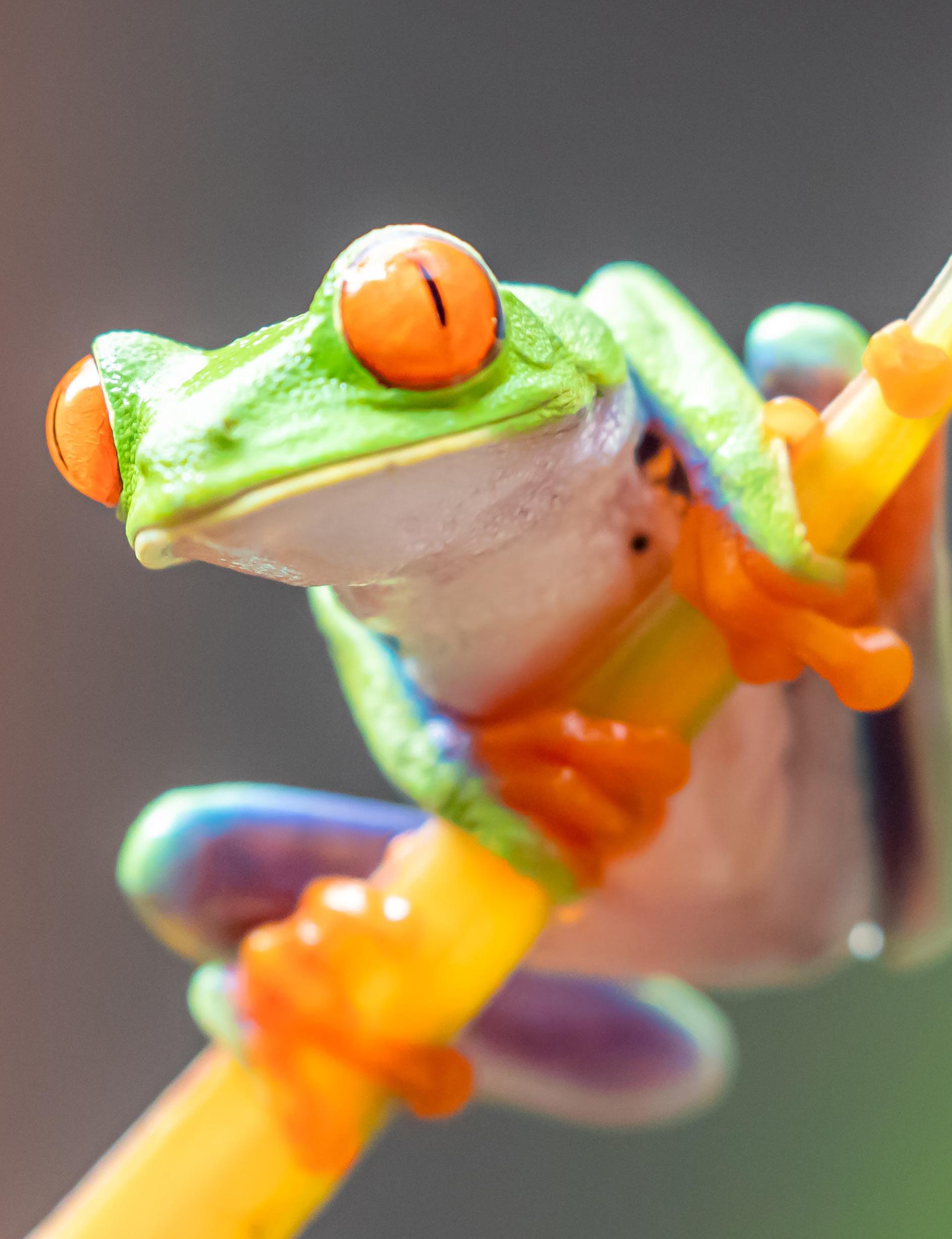
Disciplinary Core Ideas: PS3.B: Conservation of Energy and Energy Transfer
Sunlight warms Earth’s surface.
The need for shade is discussed here which is the premise for the need to build a shade structure.
Show the photo to your students while you read the passage and discuss the questions.
In a moment, I will share with you a story about a tree frog! He hopped really high and reached the canopy—the top layer of the rainforest! It was hot up there in the sunlight. He didn’t like it much, so he came back down into the forest to look for some shade.
A tree frog is a special type of frog that likes to live in trees in the rainforest. They don’t live in the water like other frogs, but their skin still needs to stay moist.
Why do you think tree frogs need shade to survive?
Example: Tree frogs have moist skin but they don’t live in ponds like other frogs. They like to stay in trees and on plants. They must have shade so they don’t dry out too much or get to hot in the bright sunlight.
What colors can you see on this colorful frog?
Example: Green, white, orange, purple, and blue.
Moist is another word for a little bit wet. If something is moist it is not dry.
Does the frog’s skin look moist or dry? How can you tell?
Example: The frog’s skin looks moist because it is shiny and glistens in the light.

On top of the canopy
There wasn’t much shade
So poor Mr. Tree Frog
Soaked up the Sun’s rays
He looked down at the forest
Where less sunlight came through
It looked nice and cool there
He knew what to do
He saw there was shade there
Because of the trees
So, downwards he scurried
To stay under the leaves
The heat of the day
Was controlled very well
In the shade of the forest
He always will dwell


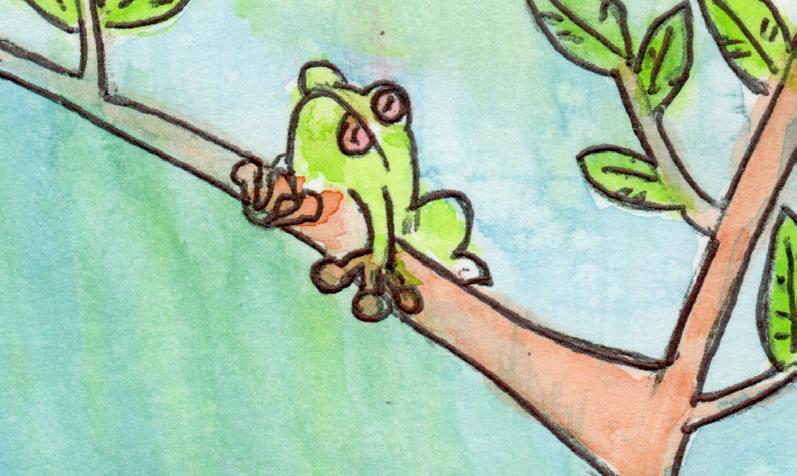
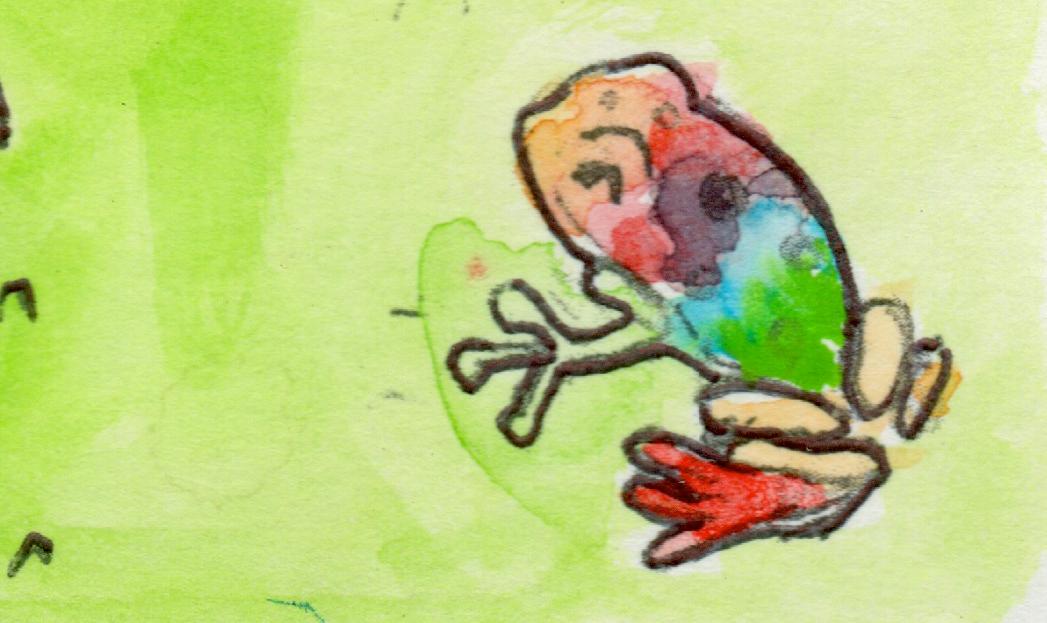
Now recite the poem on the opposite page and talk about it with your students.
Does the tree frog want to soak up the sun’s rays? Why or why not?
Example: No! Mr. Tree Frog does not want to soak up the sun’s rays. He does not want to sit in the sun because the Sun would dry out his skin. Mr. Tree frog prefers to sit in the shade so his skin can stay moist and wet.
What makes the shade in the forest? Where do you find the shade?
Example: Trees make the shade in a forest. The leaves of the trees block the Sun’s light. You find shade in the forest underneath the trees, not in the tops of the trees.
Now, sing the words of the poem to the tune of “On Top of Old Smokey.”
Song time! Sing this song to your students and have them look at the illustrations. You may also teach them the song and have them sing along. In the on-line resources, there is a sing-along video for this song so your students can follow and sing along with Beth playing her guitar. Enjoy!
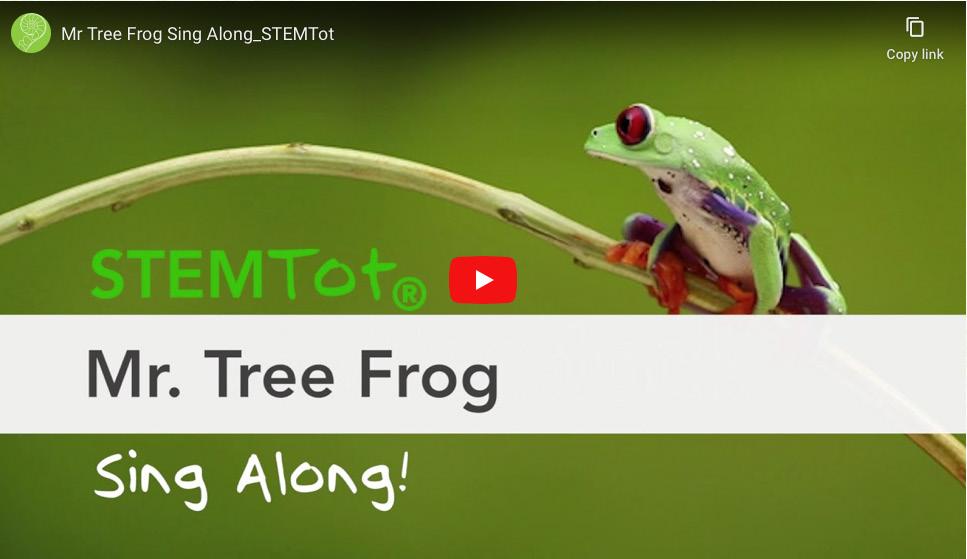
Find this video in your on-line resources for this unit.
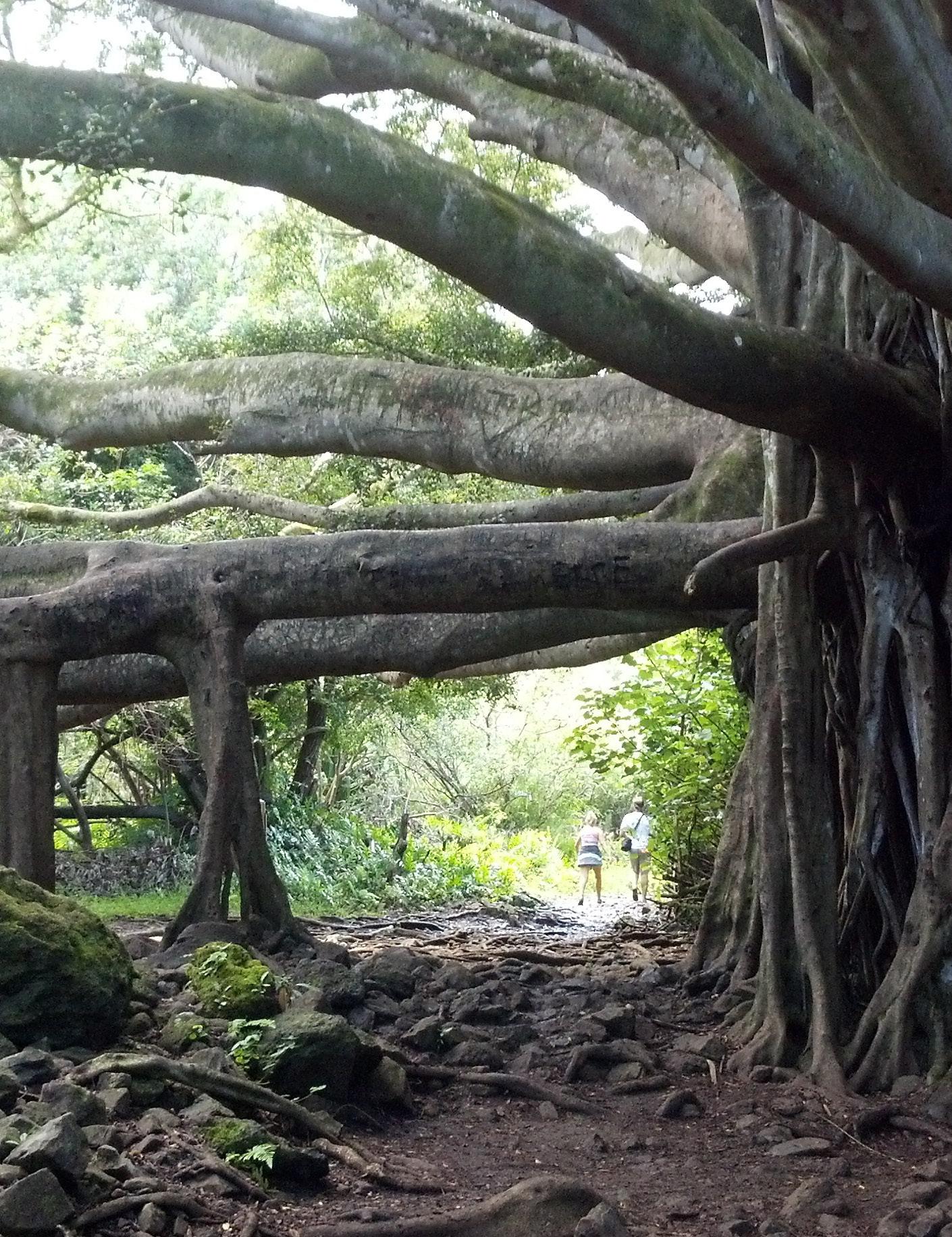
Show the photo to your students while you read the passage and discuss the questions.
When tree branches stretch out, they help stop the Sun’s light from reaching the ground. This helps us stay nice and cool underneath the trees. We plant trees on our roads and in our parks to keep us cool. We have trees at school, too! In some countries, people plant a tree called a banyan tree. This tree has branches that stretch out far to create a lot of shade.
Define
Explain
Stretch: To stretch means to straighten out and extend. Tree branches stretch out far blocking the Sun’s light.
It’s time for a poem. Everyone stand up and listen for directions to act out the poem.
(Shade your eyes and look around you)
Some trees are BIG
(Stretch your arms wide and stand on your tip-toes)
Some trees are small
(Crouch down and sit back down)
And best of all... Give yourself a big hug!
(Give yourself a big hug!)
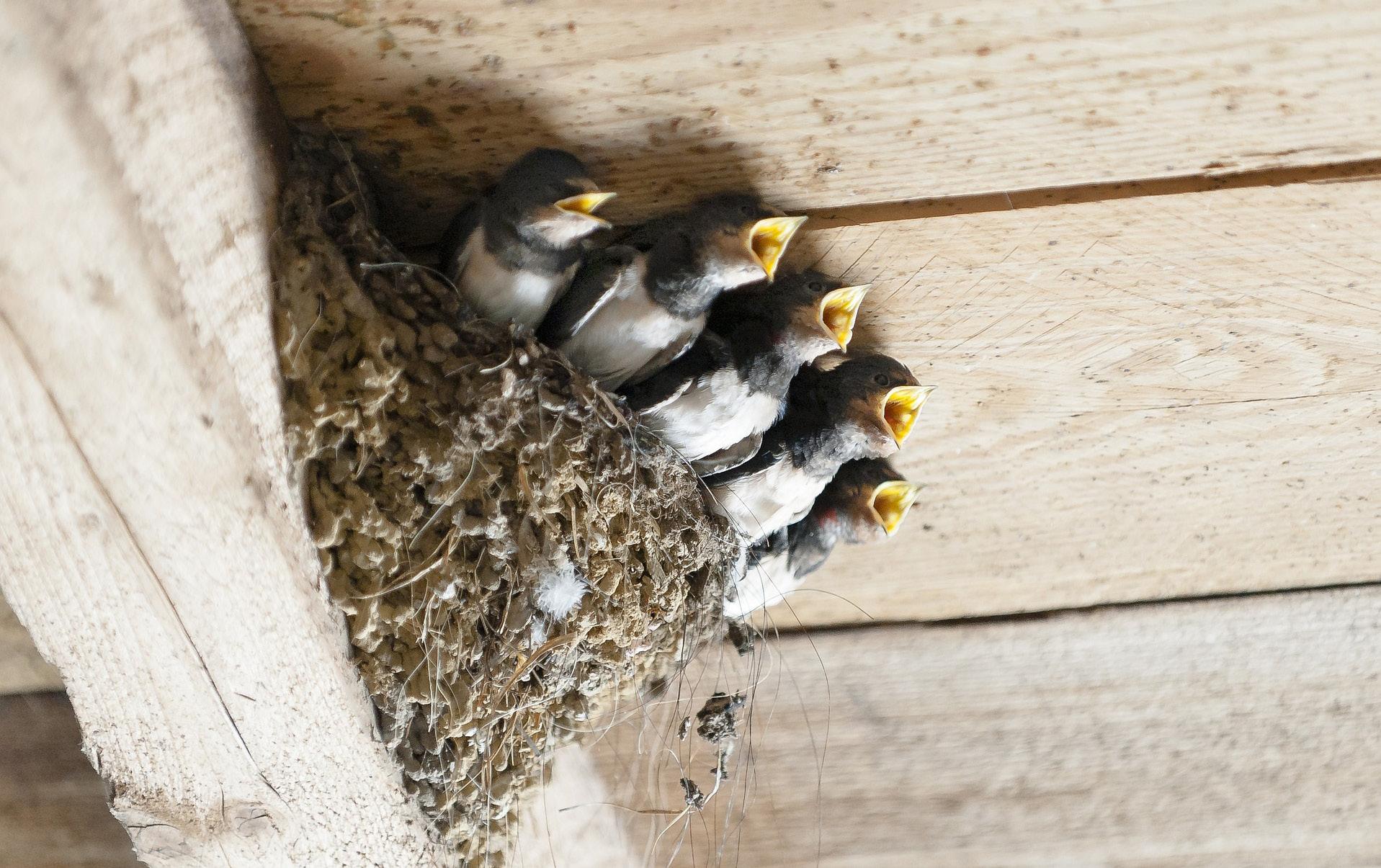
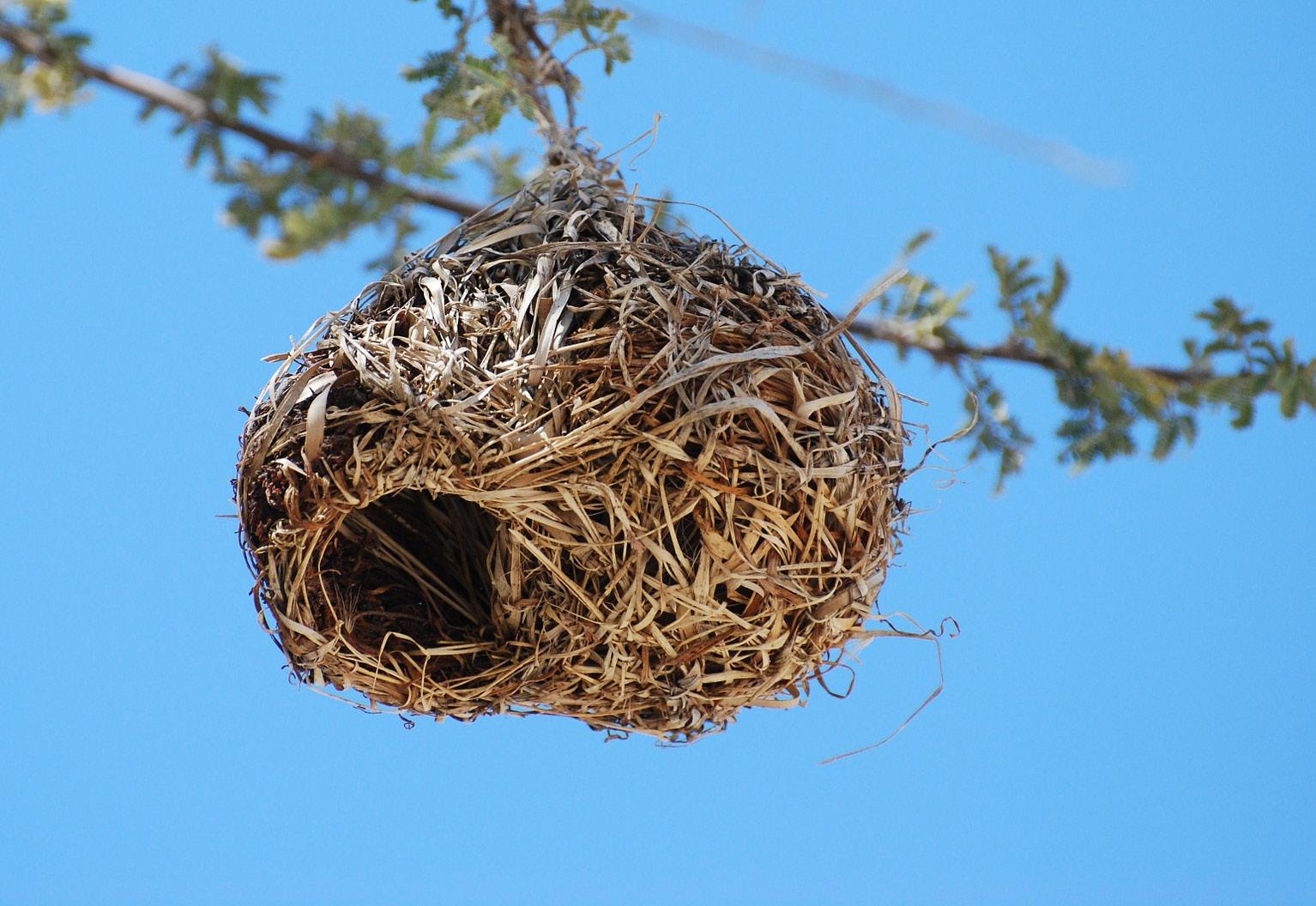


Show the photos to your students while you read the passage and discuss the questions.
Animals also need shade, and they have very clever ways of getting it. Birds build nests in shady trees and underneath man-made structures. Many animals dig holes to use as shelter. Bats use caves to escape the sunlight.
Ask
How do animals get shade?
Example: Some birds weave covered nests. Some birds build nests in shady areas such as in trees. Some animals dig holes called burrows.
How do some animals use man-made items for shelter and shade?
Many birds make nests under bridges, in buildings, or under roofs.

Now that you have introduced the idea that animals need shade just like we do, it’s story time! This story is about three birds that build nests. Some of the nests are better than others at protecting the birds from the hot sunlight. We recommend reading the story together as a class a few times. There are many details in the illustrations that will keep the story interesting again and again.


1. Weaving a ring of grass.
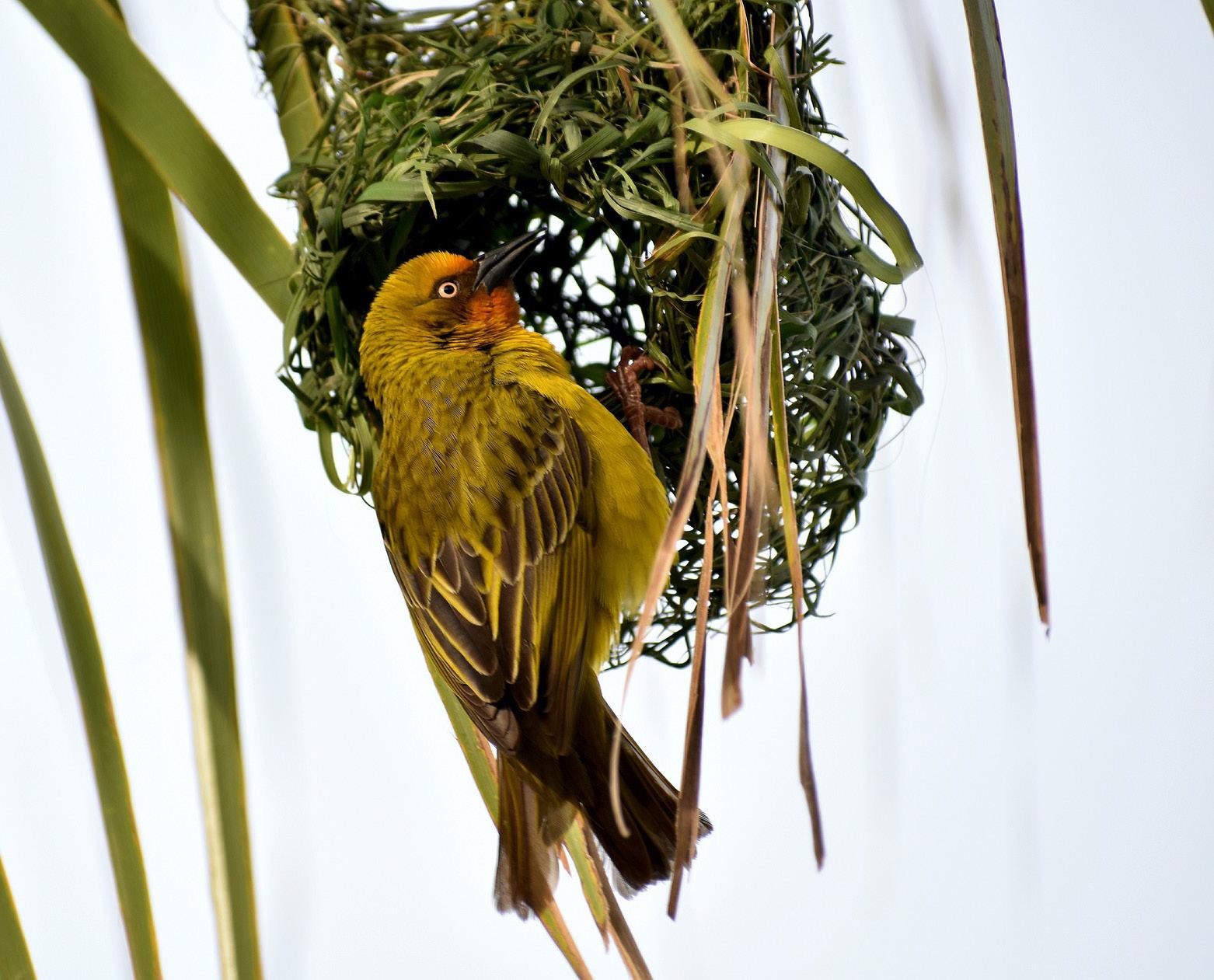
2.
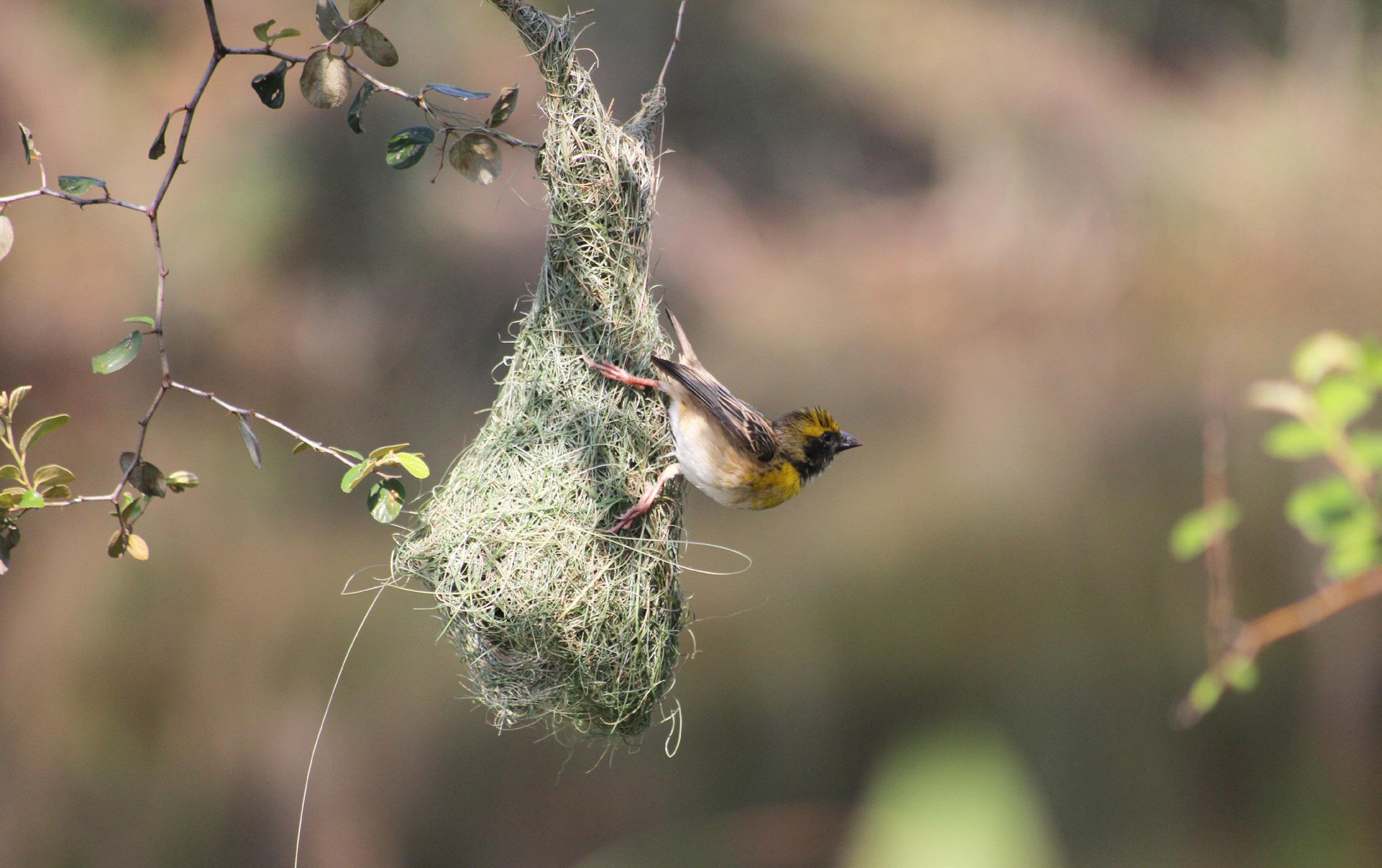
3. Building the nest larger. The nest is done!

How do weaver birds make their nests?
Example: Weaver birds weave covered nests. They start by weaving a ring with grass which they use as a perch, then they weave a basket like nest all around themselves.
Look on-line in this unit’s web-page for a short movie about how the weaver bird builds a nest. What an amazing little engineer a bird can be!
Meet the Author and Illustrator of “The Three Little Birds.”
by: Illustrated by:
Bella Hunter

Hi! I am from Bakersfield, California. I love climbing, drawing, hockey and snowboarding, being outdoors, and playing instruments. I want to be an ornithologist (bird scientist) someday.

Written
Jianing Choi

Hi! I am international student from China. I like writing, reading, drawing, swimming and cooking. I think these things make my life colorful and refreshing. I want to study architecture and biology some day.

s


L i t t l e B
hT e T h r e e

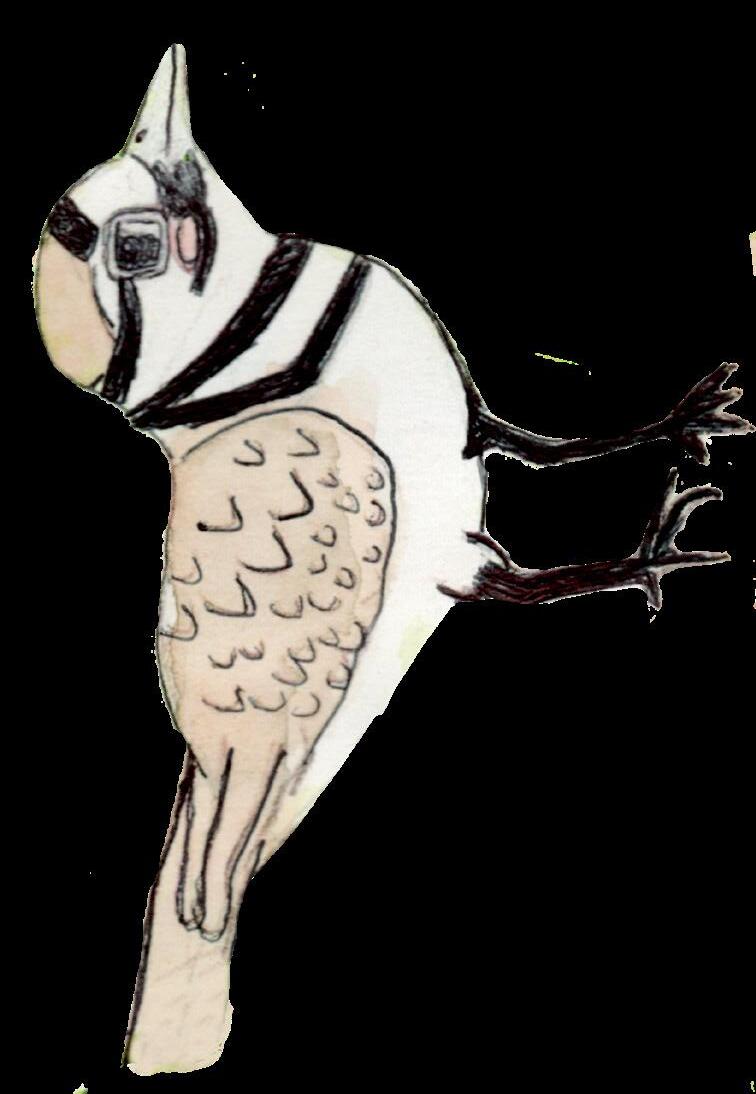
Little engineers build structures to stay cool and out of the Sun.
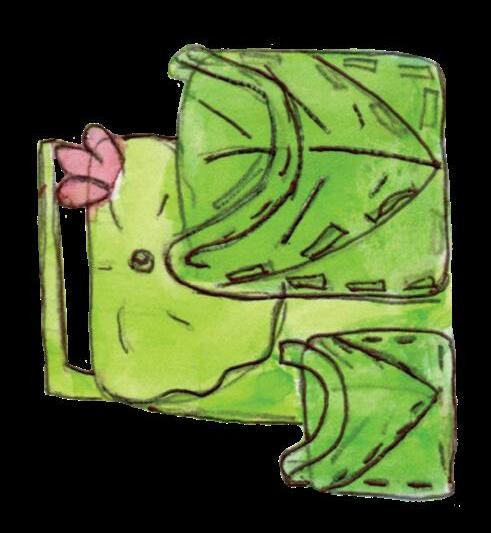





Meet the three little birds! The stars of the story!



The meadow lark eats bugs, seeds and berries. It makes its n est on the ground in open grasslands. Sometimes it covers the nest with a roof woven from grass!
The killdeer feeds on insects. It is a shorebird and it builds its nest with pebbles and seashells.

Weaver birds eat seeds and weave elaborate nests of grass which hang from branches.



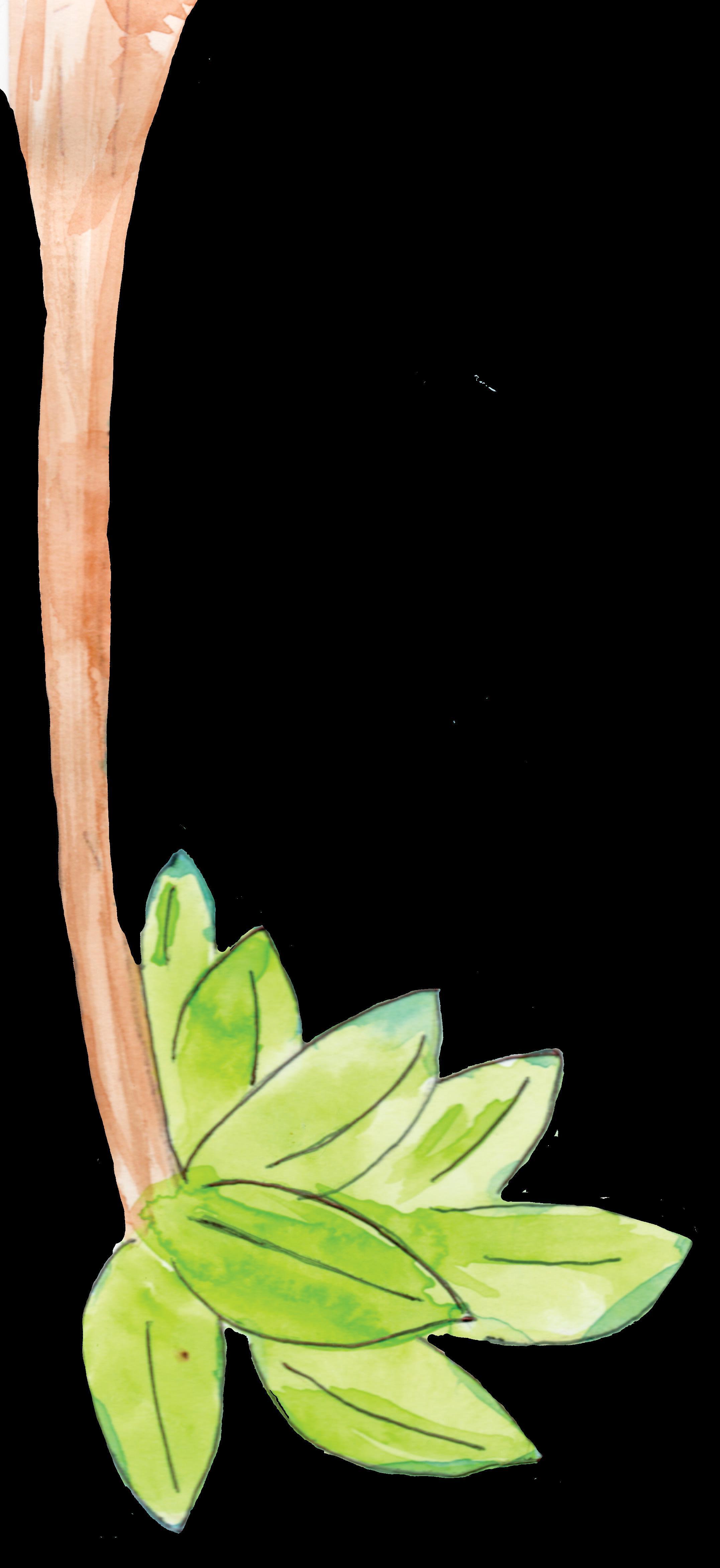


Once upon a time, there were three little birds named Lara Lark, Kelly Killdeer and Walter Weaver. They were best friends.

You can’t see me!
How many bugs can you see?

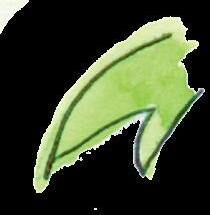
One day, they decided to leave their parents and go on a trip together to see the colorful world outside.
I see the life cycle of abutterfly!

Can you spot the birds’suitcases?

They roamed through fields and woods, exploring and having fun. None were happier than the three little birds. They easily made friends with everyone they met.
Youarewelcomehere!

Howmanyspiderscanyoucount?
We’re rebuilding our nests for the summer!

As their adventure drew to a close, many of their friends were starting to build their homes and nests. The birds realized that they also needed to protect themselves from the hot Sun. So, the three little birds decided that they too needed homes of their own to keep themselves cool and comfortable.

Can you see the life cyclehere?
Kelly Killdeer decided to build a stone nest on the ground. “Stones are the easiest things to find. It will only take me a day to build my nest, and then I will go have fun,” she said to herself. She was confident that a simple nest without any coverage would be more than enough for her. The others disagreed. “It will never protect you from the dreaded sunlight,” they told her. However, Kelly Killdeer refused to listen to them.

Those look sooo good...

Which one should I choose?
This is my house!
Lara Lark decided that a nest made of twigs and grass would make her summer much cooler. She found a little pond and decided to build her house near some short bushes. Walter Weaver quietly said that the nest wouldn’t be enough to protect Lara from the Sun on hot days. ‘Walter doesn’t know what he is talking about,’ thought
Lara Lark. After three days, she had finished her nest. Looking at her nest, she said to herself, “This is the perfect nest for me.”


He works too hard!

Walter Weaver was very small, but he was smart too. He remembered what his mother and father had taught him, “Do your best in everything,” so Walter decided to put his best effort into building a safe and comfortable nest. Walter roamed the skies for two days and finally found a forest with tall trees. It was cool in the forest where the trees cast their shadows. While Walter worked to build his nest, the other birds played.

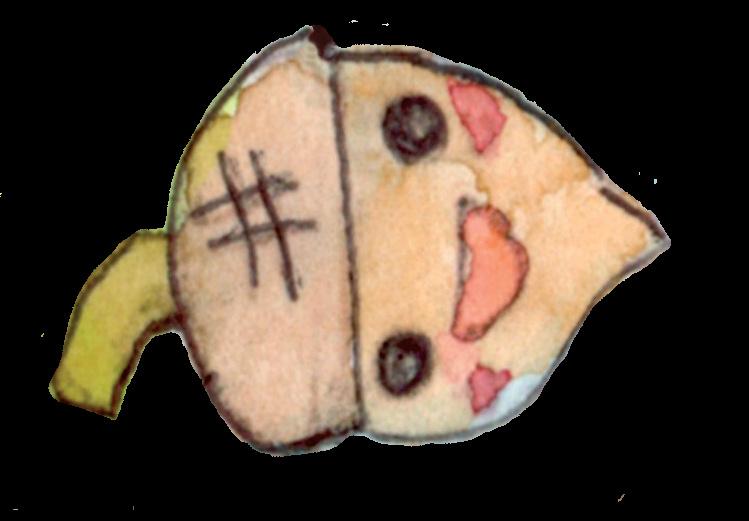
Walter Weaver picked a strong branch on which to build his new home. The branch was in the trees’ shadow for much of the day. Walter worked very hard weaving his nest from long blades of grass. He searched for grass and wove for five whole days before his nest was finally finished. Walter even wove a roof for his new home. He made such a comfortable nest!


When the birds were done building, they sat proudly in their nests. When the Sun came up, each of the three birds had very different experiences. Kelly Killdeer couldn’t stand stay in her nest all summer long. In the direct sunlight, her stone nest heated up and her feathers!

As Lara Lark sat in her nest, the shade cast by the bush was too small, it did not cover her entire nest. She had to squint her eyes in the bright sunlight, and she became so hot that she had to get up and cool off in the water. She should have built her nest farther in the bush where the leaves would shade her better.


Out of all three birds, Walter Weaver’s nest proved to be the most shady. His nest was always cool. The grass he used to weave his nest let in a nice gentle breeze. Lara Lark and Kelly Killdeer visited Walter’s nest for a lazy afternoon in the shade.

K-PS3-2. Energy
Use tools and materials provided to design and build a structure that will reduce the warming effect of sunlight on Earth’s surface.
The students work together using provided materials to build a structure to provide shade for their chocolate.
Science and Engineering Practices:
Planning and Carrying Out Investigations
Use tools and materials provided to design and build a device that solves a specific problem or a solution to a specific problem.
The shade will solve the problem of chocolate melting.
Observable features of the student performance:
1. Using scientific knowledge to generate design solutions
b. With support, students individually describe (ii.) . The design solution.

Observable features of the student performance:
1. Using scientific knowledge to generate design solutions
a. Students use given scientific information about sunlight’s warming effect on the Earth’s surface to collaboratively design and build a structure that reduces warming caused by the sun.
Observable features of the student performance:
1. Using scientific knowledge to generate design solutions
b. With support, students individually describe (i.) the problem.
Students identify that the problem is the warm sun melts the chocolate.
Students identify that putting the chocolate in the shade will create a design solution to the problem.
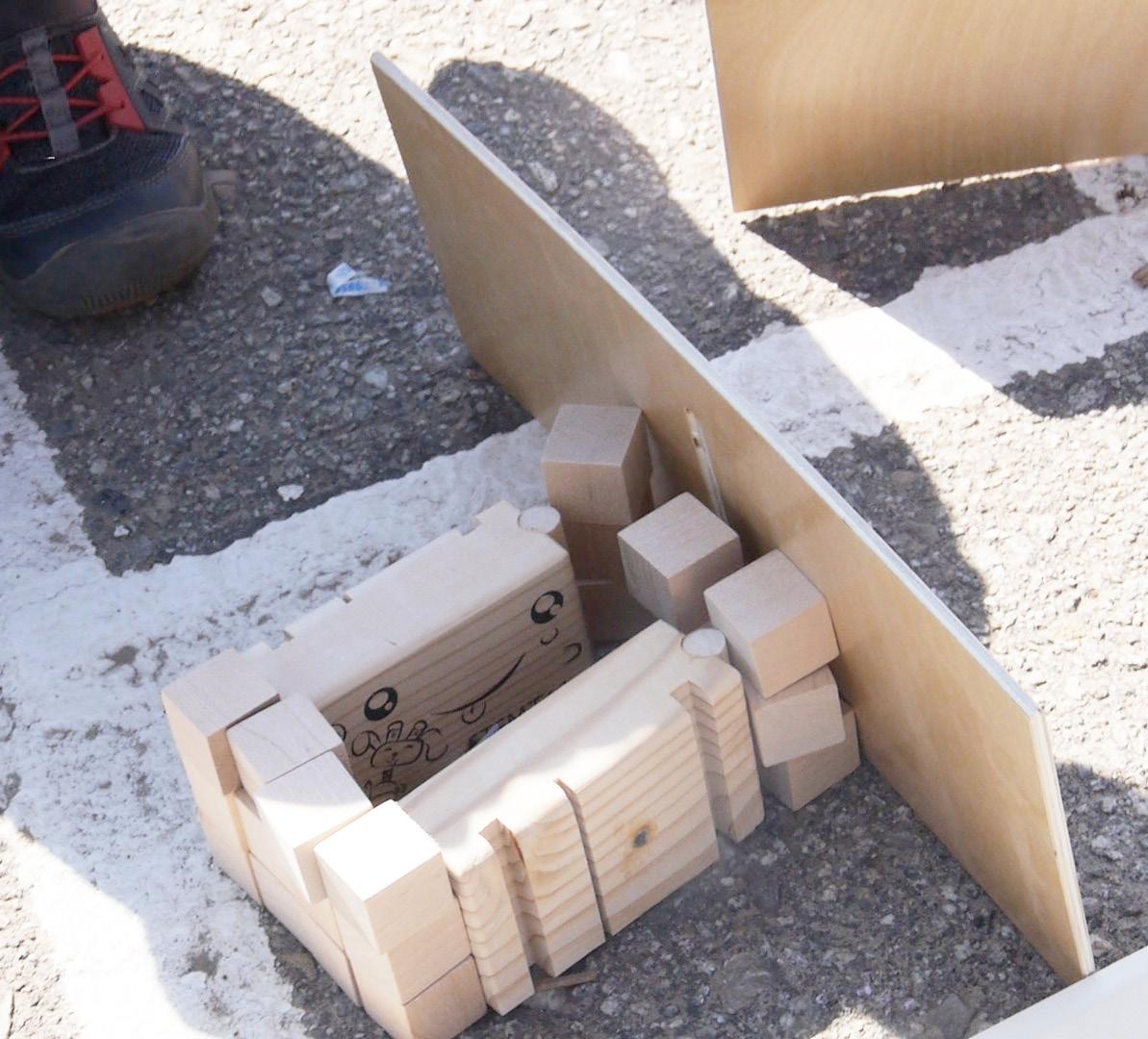
Now you get to try making your own shade structure. You can work with a partner to build something that makes shade.
Help!
melting! Do you like it when your chocolate gets all sticky and melted? I don’t! But what if you need to take your chocolate outside? Your chocolate needs protection from the warm sun! Can you build a structure to keep your chocolate from melting?
Look at the picture. These students have made a small shade structure. Look, the things they made are like tiny little houses!
Ask
Can you see the chocolate the girl has? What do you think will happen to the chocolate if she leaves it in the Sun?
Example: The chocolate will melt easily if it is left in the sunlight. It will become a gooey, sticky mess.
What do you think will happen to the chocolate if she puts it in the shade that she made?
Example: The chocolate will be protected from the sunlight. It will not melt or become sticky if it remains in the shade.
Activity Plan:
Test your shade: Place a thermometer or a piece of chocolate in your shade to see what happens. 1. 2. 3. 4.
Get a partner: Use teamwork to build your shade structure. Group your students into pairs.
Get your materials: Every group will use the same materials to make a structure.
Get the Blocky and Roxy Ramp Kea and the Cubie Blocks Koa.
Make a shade structure: Be creative! There are many ways to make shade with your materials.
Think Critically Explore
Observable features of the student performance:
1. Using scientific knowledge to generate design solutions
b. (iii) In what way the design solution uses the given scientific information.
Students identify that structures which provide shade block sunlight and keep things beneath them cool.

Observable features of the student performance:
2. Describing* specific features of the design solution, including quantification when appropriate
a. Students describe* that the structure is expected to reduce warming for a designated area by providing shade.
b. Students use only the given materials and tools when building the structure.
Students identify which materials they will use before building.
Observable features of the student performance:
3. Evaluating potential solutions
a. Students describe* whether the structure meets the expectations in terms of cause (structure blocks sunlight) and effect (less warming of the surface).
Cooperate with your partner to build a shade structure.

Cubie blocks3 handfuls
Students describe how they will test if the structure is working to solve the problem. Once they test it they can determine if the design was effective.

Blocky - 2 Roxy Ramp - 3
Explain
Show the photo on the opposite page to your class.
Materials needed: In this photo you can see the materials that you and your partner will need. One partner can carry your Cubie blocks on a tray and the other partner may carry three ramps and two Blockys.
Come up to get your materials when I call your names. When you get your materials you may go outside and start to build your shade structure.
What materials does each group need to get?
Example: three handfuls of Cubie blocks on a tray, two Blockys, and two Roxy ramps.
Explain
Building instructions: Remember, you are building a structure to make shade, like a little house, umbrella or hat. You can put the materials together however you would like to. I am excited to see how you use your creativity to make your structure!
Why does a canopy, roof, or umbrella help us solve our problem?
Example: they block sunlight and keep things under them cool.
Once you make your structure, how will you test if the shade is working to reduce warming from the Sun?
Example: There are many ways you can test your shade. Encourage students to think of ideas. Guide them toward the following solutions:
Explain
1. You may place your hand under the shade to see if you can feel a difference between the shade and the sunlight.
2. You may place a thermometer under the shade and compare it to the sunlight. (You may need to prepare your students to read a thermometer if you choose this option.)
3. You may place a chocolate in your shade and compare it to another chocolate that is placed in the Sun.

Guide your students to complete these pages of their books.

K-PS3-2. Energy
Use tools and materials provided to design and build a structure that will reduce the warming effect of sunlight on Earth’s surface.
Many human made solutions for providing shade are discussed and pictured here.

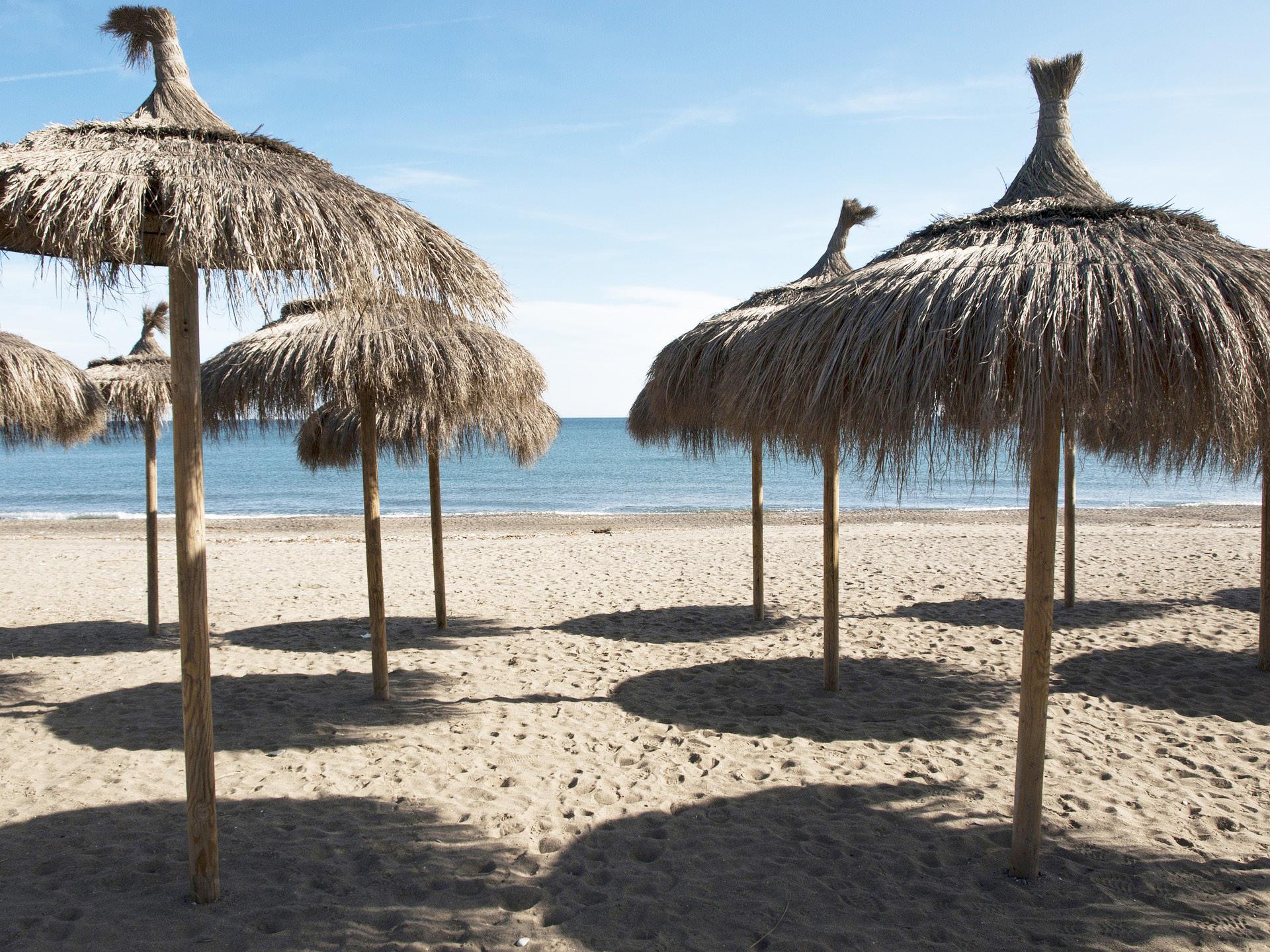
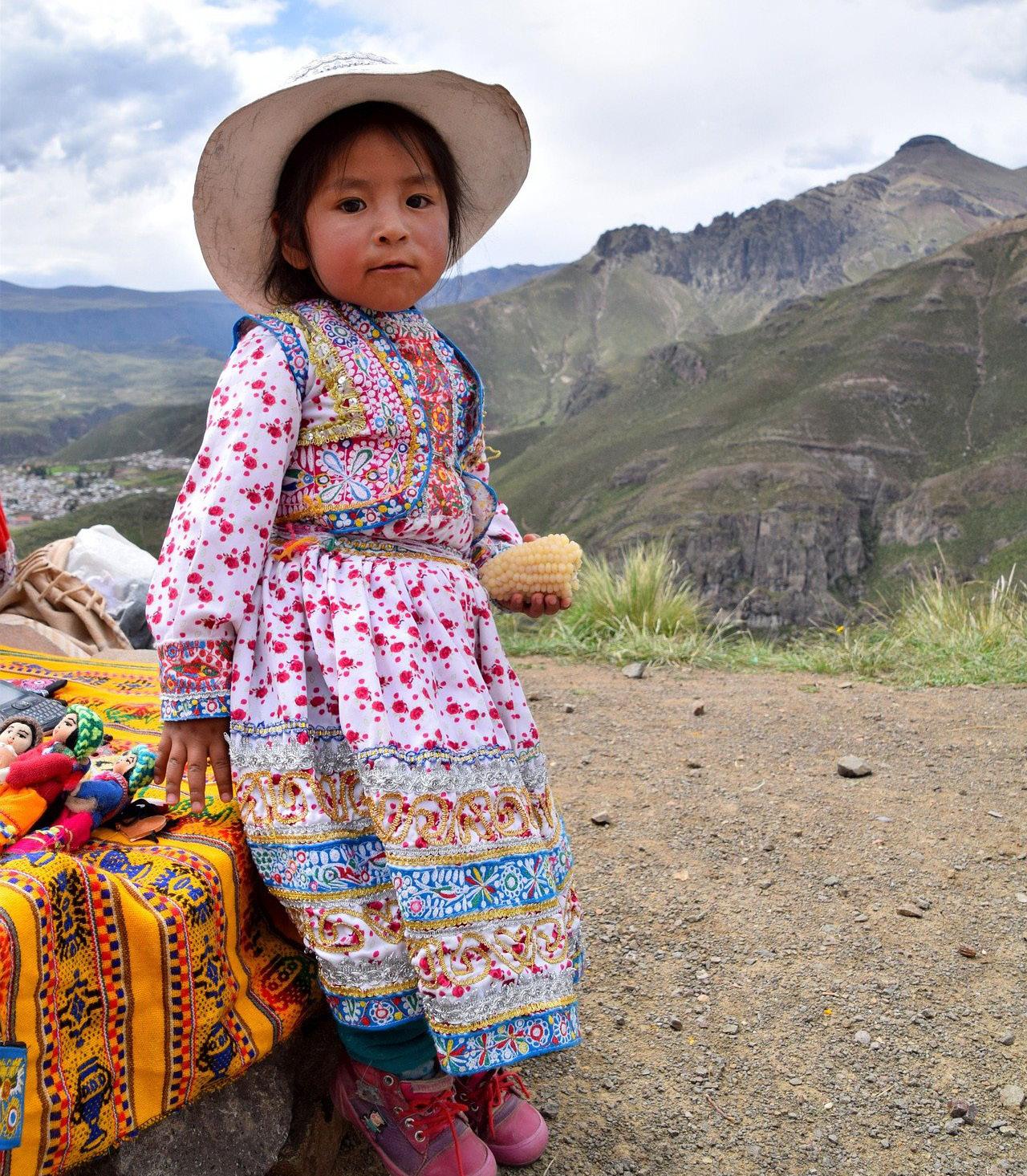


Show the photo to your students while you read the passage and discuss the questions.
People make things that give us shade. We make things such as sunglasses to protect our eyes from direct sunlight! Do you ever wear a big floppy hat to go to the beach? The hat protects your face from the Sun.
Do you think these hats make some shade for these children?
Example: This little girl has a big hat to protect her face. This little boy has a hat that is woven from the leaves of a coconut tree.
Explain
Ask
Umbrellas aren’t just useful for when it’s raining. They also give us shade.
What things do you see in these pictures that people make to create shade?
Example: Hats, sun umbrellas, covered sports areas.
K-PS3-2. Energy
[Clarification Statement: Examples of structures could include umbrellas, canopies, and tents that minimize the warming effect of the sun.]
A tent is used as an example of a human made solution to making shade.

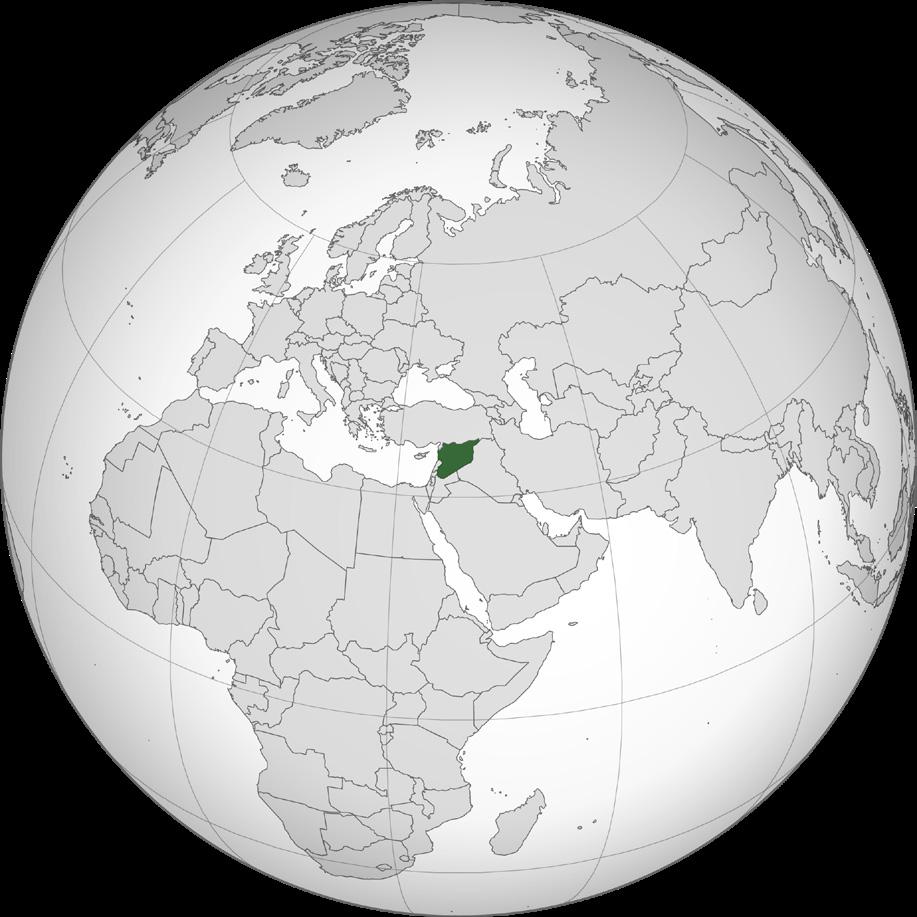
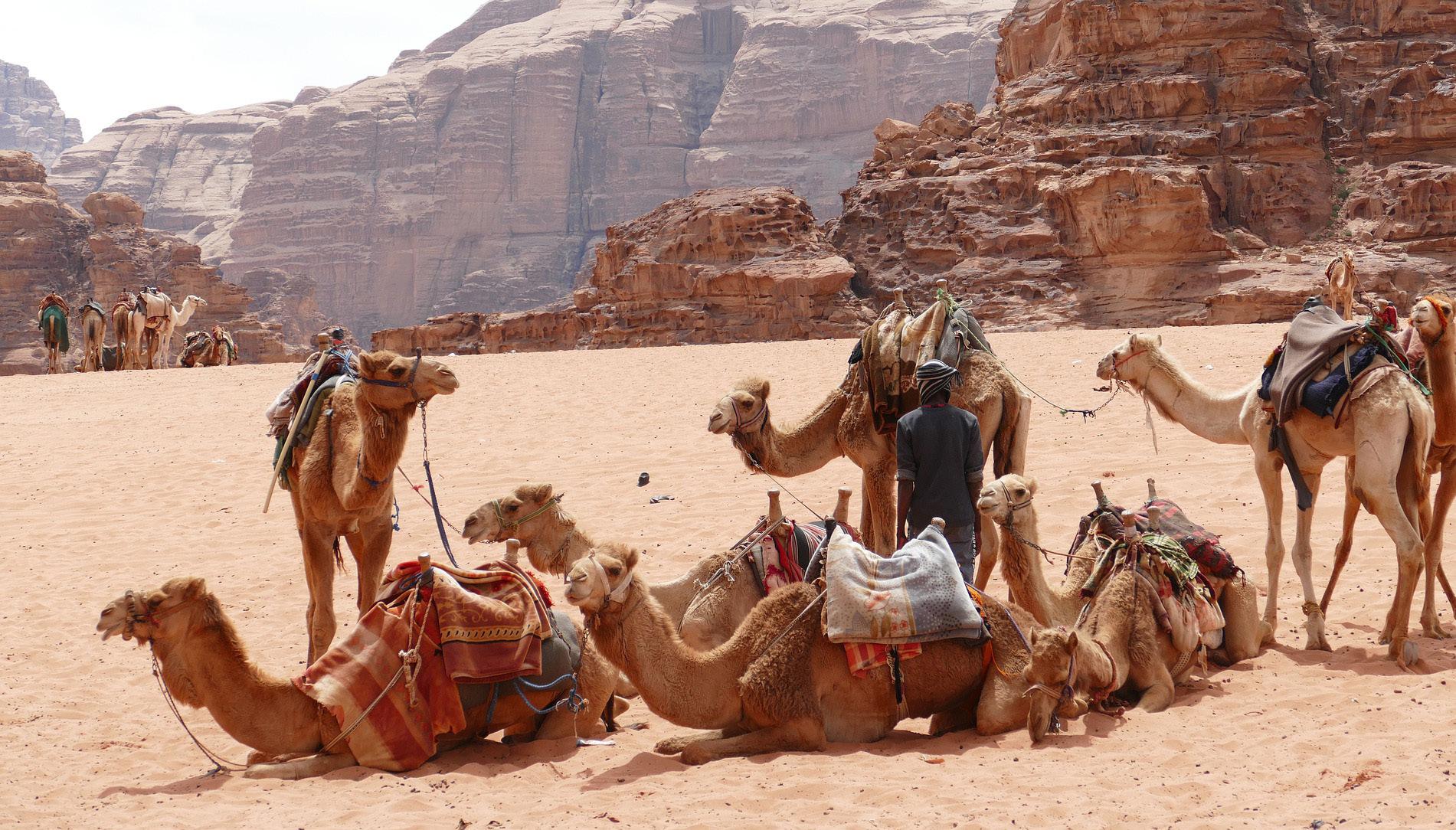

Show the photo to your students while you read the passage and discuss the questions.
People around the world make many different types of shade structures. This is a Bedouin tent in the Syrian Desert. The Arab people use tents like these to get some shade in the scorching sun. Do you think the camels fit inside too?
Do you think the camels fit inside too?
No! The camels are not allowed inside the tent! People sit on carpets and blankets inside the tent. They have a fire inside the tent where they cook their food.
The Bedouin people travel through the desert throughout the different seasons of the year to find pasture land for their animals to eat. A pasture is a grassy place that animals can graze for food. The camels carry the tent for the Bedouin people.
Explain
Can you see Syria on the globe?
Example: Syria is the country highlighted in green on the globe. It is in the Middle East, in the Arabian Peninsula. It is near the continent of Africa.
The Bedouin tent is made of wool fabric made from camel hair. The fabric is propped up using sticks and short pieces of rope.
K-PS3-2. Energy
[Clarification Statement: Examples of structures could include umbrellas, canopies, and tents that minimize the warming effect of the sun.]
A hut is used as an example of a human made solution to making shade.


Explain Ask
So many natural things can give us shade! Many natural materials are used to make shade because they are easy to find.
What do you think this home is made out of?
Straw, mud and sticks.
Show the photo to your students while you read the passage and discuss the questions.
Villages in India and Pakistan have homes made out of a mixture of straw and mud. The roof is made of straw to help keep the home cool.
K-PS3-2. Energy
[Clarification Statement: Examples of structures could include umbrellas, canopies, and tents that minimize the warming effect of the sun.]
A stone structure is used as an example of a human made solution to making shade.

USA
State: Arizona
Ask
What do you think this home is made out of?
Rocks and mud.
Show the photo to your students while you read the passage and discuss the questions.
The ancient Anasazi people made houses out of stone to keep them cool during the hot summer. Their favorite places to build their homes were underneath steep, overhanging cliffs where their houses were shaded by the canyon for more than half the day.
Ask
Explain
Why do you think the Anasazi built their homes underneath overhanging cliffs?
Example: The overhanging cliff is much like a hat for a house. Just like a hat makes shade for your face, the cliff overhang makes shade for this entire house.
The Anasazi people lived 2,000 years ago, so they had to build their houses out of natural materials. Because they lived in the desert, rocks and mud were the perfect material to use.
K-PS3-2. Energy
[Clarification Statement: Examples of structures could include umbrellas, canopies, and tents that minimize the warming effect of the sun.]
A house made from sticks is used as an example of a human made solution to making shade.


Ask
What do you think this home is made out of?
Example: The house looks like it is made from sticks, string, and rope.
Show the photo to your students while you read the passage and discuss the questions.
This house uses bundles of sticks to create shade. In this desert there are no trees nearby.
The person who built this house collected sticks to make a shade shelter.
Ask
What do you think they could use to hold the sticks together?
Example: To hold the house together people could use string, rope, or wire. Can you see any string or rope in the wall of the house holding it together? You could even weave the sticks together. Can you see how the sticks are woven together above the door?
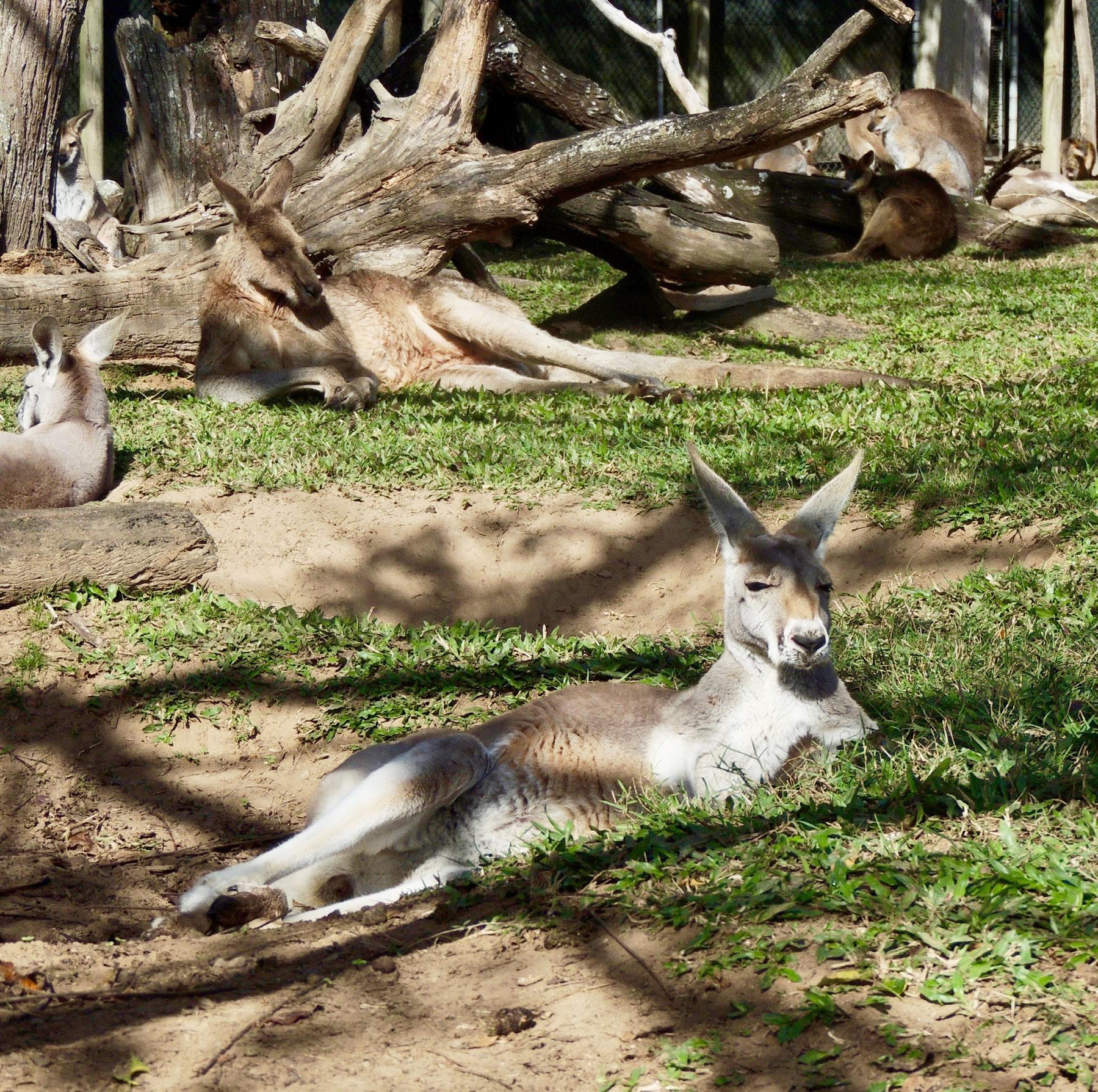
Where can we find shade?
How does a shady spot feel?
We can find shade in many different types of places. We make shade with hats, sunglasses, umbrellas, tents and buildings. Shade spots feel nice and cool because they shade us from the sun’s light.
Explain the Phenomenon


